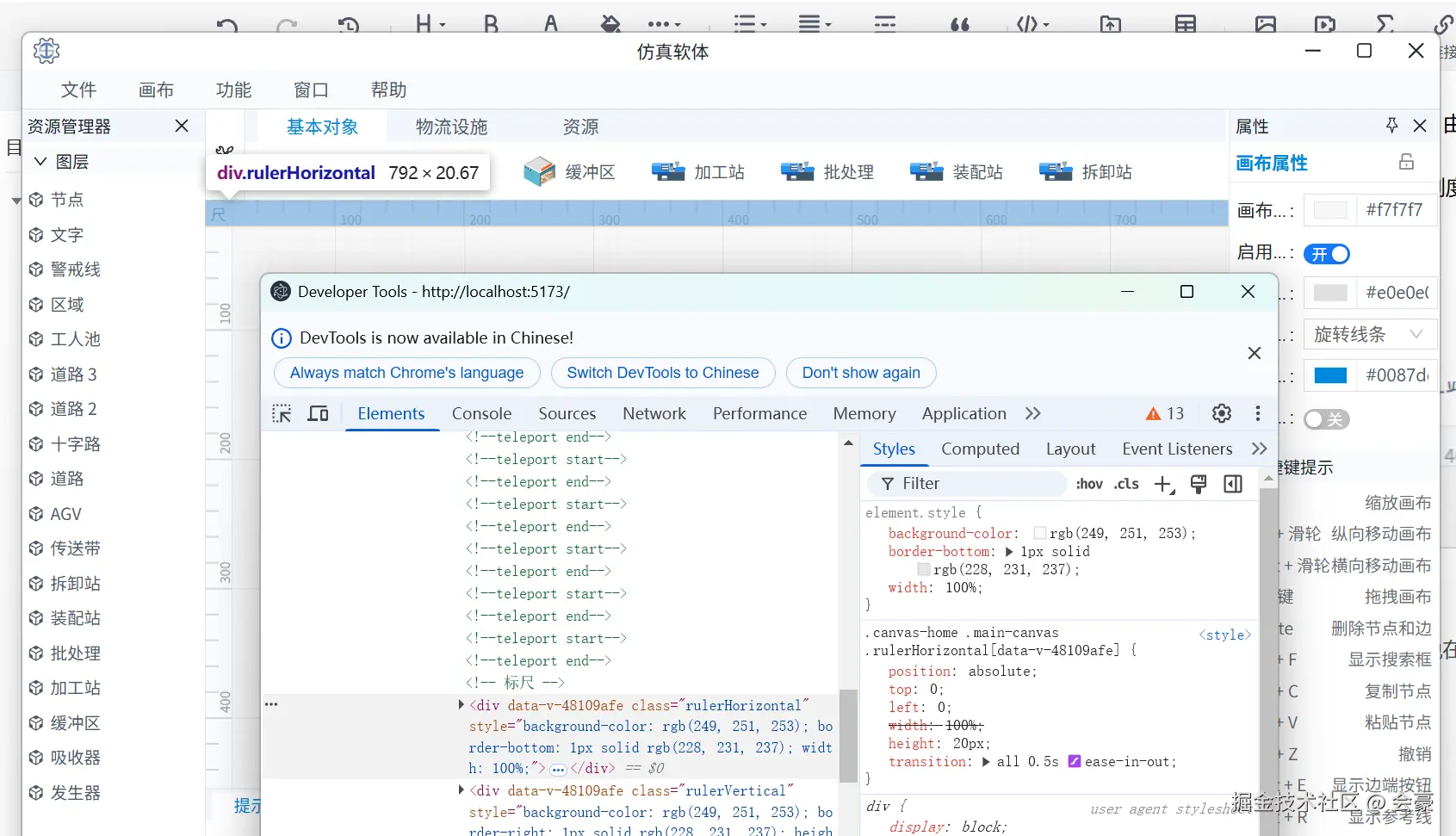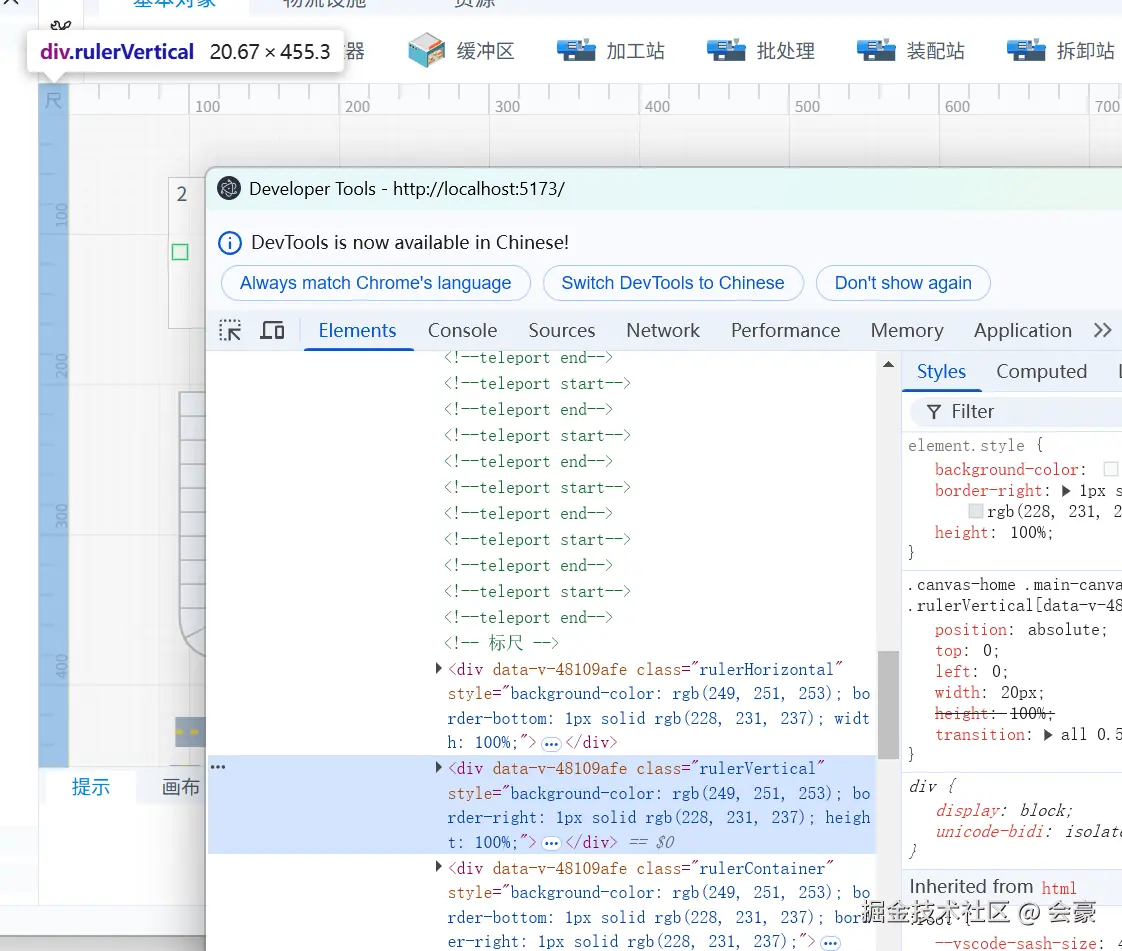在这篇文章中,主要讲一下标尺组件,这也是一个自定义的组件,核心是canvas,如图一

图一
这个刻度尺是和画布相结合,当画布移动时,刻度尺也会跟随移动,画布缩放时,刻度尺也会跟随缩放
话不多说,先展示核心代码
标尺组件
html
<template>
<canvas ref="canvasRulerRef" class="ruler-canvas"></canvas>
</template>
<script setup lang="ts">
import { ref, onMounted, onBeforeUnmount, watch, nextTick } from 'vue'
const props = defineProps({
direction: { type: String as () => 'horizontal' | 'vertical', default: 'horizontal' },
tickColor: { type: String, default: '#ccc' },
textColor: { type: String, default: '#999' },
unitSize: { type: Number, default: 100 },
subTickCount: { type: Number, default: 5 },
offset: { type: Number, default: 0 },
valueScale: { type: Number, default: 100 },
textOffsetX: { type: Number, default: 4 },
textOffsetY: { type: Number, default: 10 }
})
const canvasRulerRef = ref<HTMLCanvasElement | null>(null)
let resizeObserver: ResizeObserver | null = null
const drawRuler = () => {
const canvas = canvasRulerRef.value
if (!canvas) return
const ctx = canvas.getContext('2d')
if (!ctx) return
const dpr = window.devicePixelRatio || 1
const rect = canvas.getBoundingClientRect()
canvas.width = rect.width * dpr
canvas.height = rect.height * dpr
ctx.scale(dpr, dpr)
const width = rect.width
const height = rect.height
ctx.clearRect(0, 0, width, height)
const {
direction,
unitSize,
offset,
subTickCount,
valueScale,
tickColor,
textColor,
textOffsetX,
textOffsetY
} = props
const step = unitSize / subTickCount
const startSub = ((-offset % step) + step) % step
const firstSubIndex = Math.floor((offset + startSub) / step)
ctx.strokeStyle = tickColor
ctx.fillStyle = textColor
ctx.font = '10px sans-serif'
ctx.textAlign = 'left'
ctx.textBaseline = 'top'
if (direction === 'horizontal') {
// 小刻度
for (let i = 0; i <= Math.ceil(width / step); i++) {
const x = startSub + i * step
const globalIndex = firstSubIndex + i
if (globalIndex % subTickCount === 0) continue
ctx.beginPath()
ctx.moveTo(x, 0)
ctx.lineTo(x, height * 0.5)
ctx.stroke()
}
// 主刻度
const start = ((-offset % unitSize) + unitSize) % unitSize
const startIndex = Math.floor((offset + start) / unitSize)
for (let x = start, i = 0; x <= width; x += unitSize, i++) {
const value = (startIndex + i) * valueScale
ctx.beginPath()
ctx.moveTo(x, 0)
ctx.lineTo(x, height)
ctx.stroke()
ctx.fillText(`${value}`, x + textOffsetX, textOffsetY)
}
} else if (direction === 'vertical') {
// 小刻度
for (let i = 0; i <= Math.ceil(height / step); i++) {
const y = startSub + i * step
const globalIndex = firstSubIndex + i
if (globalIndex % subTickCount === 0) continue
ctx.beginPath()
ctx.moveTo(0, y)
ctx.lineTo(width * 0.5, y)
ctx.stroke()
}
// 主刻度
const start = ((-offset % unitSize) + unitSize) % unitSize
const startIndex = Math.floor((offset + start) / unitSize)
for (let y = start, i = 0; y <= height; y += unitSize, i++) {
const value = (startIndex + i) * valueScale
ctx.beginPath()
ctx.moveTo(0, y)
ctx.lineTo(width, y)
ctx.stroke()
ctx.save()
ctx.translate(textOffsetX, y + textOffsetY)
ctx.rotate(-Math.PI / 2) // 逆时针旋转90度(文字朝下)
ctx.fillText(`${value}`, 0, 0)
ctx.restore()
}
}
}
onMounted(() => {
nextTick(() => {
drawRuler()
})
resizeObserver = new ResizeObserver(() => {
drawRuler()
})
if (canvasRulerRef.value) {
resizeObserver.observe(canvasRulerRef.value)
}
})
onBeforeUnmount(() => {
if (resizeObserver && canvasRulerRef.value) {
resizeObserver.unobserve(canvasRulerRef.value)
}
})
watch(
() => [
props.direction,
props.unitSize,
props.subTickCount,
props.offset,
props.tickColor,
props.textColor,
props.valueScale,
props.textOffsetX,
props.textOffsetY
],
drawRuler
)
</script>
<style scoped>
.ruler-canvas {
width: 100%;
height: 100%;
display: block;
background-color: transparent;
pointer-events: none;
}
</style>这个组件的核心部分是canvas,至于为什么不用svg,这就要讲到这两个的区别了
1. 性能与适用场景
-
SVG 适合:
- 图标、Logo、图表(如流程图、地图)等需要无损缩放的场景。
- 交互需求简单的图形(如点击某个图形元素触发事件)。
- 图形元素数量较少的情况(因为每个元素都是 DOM 节点,过多会影响性能)。
-
Canvas 适合:
- 像素级操作的场景(如照片编辑、滤镜效果)。
- 动态生成的复杂图形(如游戏画面、数据可视化动画)。
- 图形元素数量极多(如粒子效果),此时 Canvas 性能更优。
2. 交互与事件
- SVG :每个图形元素都是独立的 DOM 节点,可直接绑定事件(如
onclick),交互逻辑简单直观。 - Canvas:没有内置的图形元素事件系统,需通过计算鼠标坐标与绘制区域的关系手动实现交互,复杂度较高。
然后我们再回到我们的标尺组件,标尺组件总共接受以下几个参数
- direction: { type: String as () => 'horizontal' | 'vertical', default: 'horizontal' }, //方向
- tickColor: { type: String, default: '#ccc' }, //刻度颜色
- textColor: { type: String, default: '#999' }, //字体颜色
- unitSize: { type: Number, default: 100 }, //单位长度,这个意思就是大刻度间距是多少,由于我们的标尺组件是分为大刻度和小刻度,这个参数指的就是大刻度,如图二
- subTickCount: { type: Number, default: 5 }, //小刻度的份数,是指大刻度之间有几份小刻度
- offset: { type: Number, default: 0 }, //标尺开始的刻度值
- valueScale: { type: Number, default: 100 }, //标尺的缩放值
- textOffsetX: { type: Number, default: 4 }, //文字的X轴偏移量
- textOffsetY: { type: Number, default: 10 } //文字的Y轴偏移量

图二
我之所以要自定义自己的标尺组件,是因为某些其他的标尺所占据的区域是整个页面,比如说在我的标尺组件中,横向标尺所占领的区域的高度就是20,不会影响到其他组件,如图三

图三
同理,纵向标尺所占据区域的宽度也就是20,如图四

图四
接下来我们看一下在画布中怎么应用
实际应用
1. 首先准备div
html
<!-- 标尺 -->
<div
class="rulerHorizontal"
:style="{
backgroundColor: themeStyle[theme].backgroundColor3,
borderBottom: '1px solid ' + themeStyle[theme].borderColor1,
width: isCanvasRuler ? '100%' : '0px'
}"
>
<Ruler
:direction="'horizontal'"
:offset="canvasPosition.x"
:unit-size="canvasScale * 100"
/>
</div>
<div
class="rulerVertical"
:style="{
backgroundColor: themeStyle[theme].backgroundColor3,
borderRight: '1px solid ' + themeStyle[theme].borderColor1,
height: isCanvasRuler ? '100%' : '0px'
}"
>
<Ruler
:direction="'vertical'"
:offset="canvasPosition.y"
:unit-size="canvasScale * 100"
:text-offset-x="10"
:text-offset-y="-4"
/>
</div>
<div
class="rulerContainer"
:style="{
backgroundColor: themeStyle[theme].backgroundColor3,
borderBottom: '1px solid ' + themeStyle[theme].borderColor1,
borderRight: '1px solid ' + themeStyle[theme].borderColor1
}"
@click="isCanvasRuler = !isCanvasRuler"
>
<span>尺</span>
</div>还有样式代码
css
.rulerContainer {
position: absolute;
top: 0;
left: 0;
width: 20px;
height: 20px;
font-size: 12px;
color: #808080;
line-height: 20px;
text-align: center;
user-select: none;
cursor: pointer;
}
.rulerHorizontal {
position: absolute;
top: 0;
left: 0;
width: 100%;
height: 20px;
transition: all 0.5s ease-in-out;
}
.rulerVertical {
position: absolute;
top: 0;
left: 0;
width: 20px;
height: 100%;
transition: all 0.5s ease-in-out;
}然后就可以直接使用了
2. 绑定缩放和位移
大家可以看到,在我的两个标尺都,都绑定了这两个参数
- canvasPosition
- canvasScale
那么当我们的画布进行缩放或移动时,只需要改变这两个参数的数值即可,如下代码所示
ts
//画布-缩放事件
canvas.on('scale', () => {
//获取canvas的缩放级别
const zoom = canvas.zoom()
bgCanvas.zoom(zoom, { absolute: true })
const { canvasScale } = storeToRefs(useCanvasParameterStore())
canvasScale.value = zoom
})
//画布-移动事件
canvas.on('translate', ({ tx, ty }: { tx: number; ty: number }) => {
const { canvasPosition } = storeToRefs(useCanvasParameterStore())
canvasPosition.value.x = -tx
canvasPosition.value.y = -ty
})到此我们的标尺组件就讲解完毕了